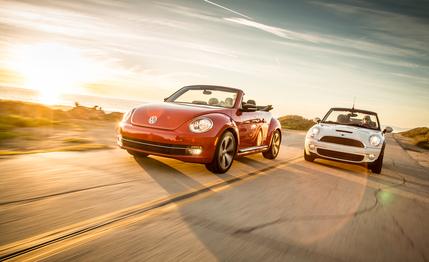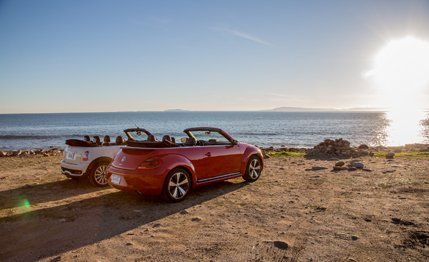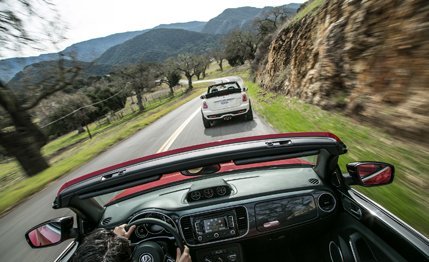 Comparison Tests
Comparison Tests
The Volkswagen Beetle Turbo and the Mini Cooper S convertibles are built for the fashionable, for people who know they look great in linen pants and that denim makes their butts seem huge. They can tell a genuine Barcelona chair from a knockoff at 60 yards. Style counts. So does cute. Performance? Utility? Not really.
But must fashionistas suffer to be chic? Both the Mexican-made Beetle and the Brit-built Mini convertibles are compromised by their self-conscious designs. They’ve got tiny, nearly useless trunks. Big, fluffy-white Samoyeds may look stunning sitting in the open air on either of the cars’ rear seats, but human beings will be cramped. When the tops are up, an entire Lululemon store could hide in their blind spots, but neither car is available with a rearview camera. In each, there are elements that may initially seem like sweet eccentricities but become irritating affectations in daily use. And all that’s above and beyond the extra weight and compromised structure inherent in virtually every convertible.

Prices for this pair start within an eyelash extension of one another. The Beetle Turbo convertible begins at $28,590, the Cooper S convertible at $28,850. The suite of totally adorable options added to each brought MSRPs up to $31,990 for the VW and $34,350 for the Mini.

The butched-up, second generation of the revivified Beetle may have been new in 2012, but it’s all last-generation Golf underneath. That means a transverse-mounted engine driving the front wheels and a strut-type front suspension—basically, Golf specs since 1974. All versions of the 2013 Beetle convertible borrow the multilink rear suspension from the Golf, essentially the same one that is used only in turbo-model Beetle coupes. Further, VW says that the basic unibody structure has been stiffened by 20 percent to yield a natural frequency of 17.8 Hz, which means that if a shaman of pure spirit hums loudly at exactly that frequency, the car will levitate.*
There aren’t many surprises in the Mini Cooper S convertible’s engineering, either. Check off the same boxes for the transverse engine, the front struts, and the multilink rear suspension. But the Mini Cooper S is smaller. At 146.8 inches in overall length, it’s 21.6 inches shorter than the Beetle, and at 66.3 inches wide, it spreads out 4.9 fewer inches. Yet the Mini’s 97.1-inch wheelbase is only 2.9 inches behind that of the VW’s, so the wheels are pushed out to the car’s far corners. Most critical, the Mini weighs 480 pounds less than the Beetle.

This test Beetle had VW’s ubiquitous 200-hp, 2.0-liter turbocharged four in its bulbous Shamu nose. The Cooper S uses a turbocharged 1.6-liter four rated at 181 horsepower. Both ran six-speed manual transmissions, because there’s only so far we’ll compromise for this job. A conventional six-speed automatic is optional in the Mini, and the VW can be had with a dual-clutch six-speed automatic.
Of course, convertibles need to be judged by their own standards. And sunshine, lollipops, and rainbows aren’t compatible with carrying lumber home from Lowe’s. Speed and handling matter, just not as much as comfort and an easygoing, happy personality. If ultimate performance is your goal, get the closed-roof version every time.
Then sign up for a spinning class. You need the cardio.
*Test pending. Sherman went missing.